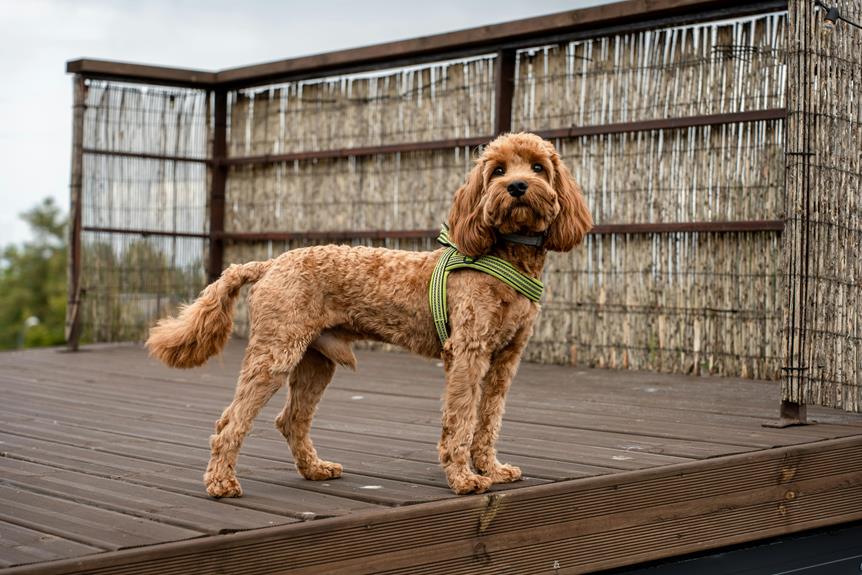
When introducing a new puppy to your older dog, prepare your home by creating separate spaces for each, puppy-proofing your surroundings, and providing designated areas with their own essentials. Start with supervised meetings in a neutral location, keeping both dogs on a leash and watching for signs of tension while encouraging positive interactions. Establish clear boundaries early on, reinforce rules consistently, and offer individual attention to each dog to build a strong bond. Following these steps will help ensure a smooth transition and a harmonious relationship between your pets.
Preparing Your Home
Before bringing your new puppy home, clear any hazards and create separate spaces for your older dog and the newcomer. Start by puppy-proofing your home, just like you'd for a baby. Get down to their level and remove any small objects they could swallow or choke on. Secure electrical cords, move toxic plants out of reach, and block off any areas that could be dangerous.
Designate specific areas for each dog to have their own space. This will prevent territorial issues and give them a safe retreat when needed. Make sure each dog has their own bed, food and water bowls, toys, and a place to relax without being disturbed. Creating separate feeding stations can also reduce potential conflicts over food.
Consider investing in baby gates or barriers to control their access to different parts of the house. This way, you can gradually introduce them to shared spaces while keeping them separated when necessary. By preparing your home in advance, you can set the stage for a smooth transition when your new puppy arrives.
Supervised First Meetings
To ensure a positive introduction between your older dog and the new puppy, supervise their first meetings closely. Begin by selecting a neutral location for their initial interaction, like a quiet room or a spacious yard, to prevent territorial issues. Keep both pets on a leash for better control, allowing them to see and smell each other without direct contact.
Watch their body language for signs of tension or aggression, intervening calmly if needed. Encourage positive interactions by rewarding good behavior with treats and praise. If either dog shows signs of discomfort, separate them and try again later. Remember to stay relaxed and patient throughout the process to help keep the atmosphere calm.
Gradually increase the length of their supervised meetings as they become more comfortable with each other. By closely monitoring their first interactions, you can help create a foundation of trust and respect between your older dog and the new puppy.
Establishing Boundaries Early
When introducing a new puppy to your older dog, it's crucial to establish boundaries early to promote harmony and respect between the two pets. Begin by setting clear rules for both dogs to follow. This includes boundaries around food, toys, sleeping areas, and any other important spaces. Make sure each dog has their own designated areas to prevent conflicts and give them a sense of personal space.
Consistency is key when it comes to enforcing these boundaries. Reinforce the rules consistently so that both pets understand what's expected of them. Use positive reinforcement, such as treats and praise, to reward good behavior and redirect any unwanted actions. By setting and consistently enforcing boundaries, you can help prevent potential conflicts and create a peaceful coexistence between your new puppy and older dog.
Remember that establishing boundaries early on not only helps prevent misunderstandings but also fosters a positive relationship between your pets based on mutual respect and understanding.
Providing Individual Attention
As your new puppy settles in with your older dog, it's important to ensure each pet receives individual attention to foster a strong bond and sense of belonging. Giving each dog one-on-one time with you helps them feel loved and valued. Spend quality time playing, training, or simply cuddling with each of your furry companions separately. This individual attention reassures them of their place in your heart and reduces any potential jealousy or rivalry.
Moreover, providing separate feeding areas for your pets can prevent food-related conflicts and ensure that each dog gets the right nutrition without feeling threatened. Additionally, taking your dogs on separate walks allows them to explore their surroundings without feeling overwhelmed or competitive.
Conclusion
Introducing a new puppy to your older dog can be a rewarding experience with the right approach. By preparing your home, supervising their first meetings, establishing boundaries early, and providing individual attention, you can help ensure a smooth transition for both dogs.
Remember to be patient and consistent in your interactions with them, and soon enough they'll become the best of friends.




